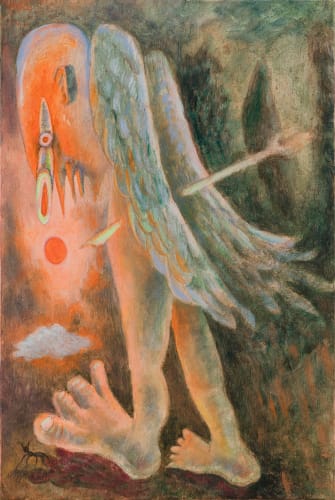ZOU Ziyao: Habitat: Curated by GAO Yumeng
“这种不可捉摸的荒诞感,我们也许由此可以触及了,在相异而博爱的世界里,诸如智力的世界里,生活艺术的世界里,或干脆说艺术的世界里。总之,这是荒诞的天地,是用自身固有的亮光照耀世界的精神形态。后者善于把得天独厚而不可改变的面目识别出来,使其容光焕发。”——引自加缪《西西弗神话》
BONIAN SPACE is pleased to announce the upcoming solo exhibition Habitat by artist Zou Ziyao from December 16, 2023 to January 15, 2024. The exhibition, curated by Gao Yumeng, presents more than 20 newly created paintings, carvings, and mixed materials by the artist.
Zou Ziyao’s works are stamped by her experiences. Her residence in and migration among cities and countries have led to contradictory and mismatched social and cultural perspectives during her growth, evolving into torn, separated, and complex identity confusion and self-awareness. A sense of detachment that is related to but not completely connected with various cultures arises. Zou instinctively searches for connections between things and people and generates new meanings from seemingly meaningless things. She slowly weaves and connects different things around her like adhesive, trying to establish a confident and consistent system.
Since then, painting that transcends language barriers has become a means for her to “survive” and express herself in an unfamiliar environment. Through visualizing her perception and imagination of her surroundings, she constantly seeks ways to establish inner stability and strengthen herself. As she grew up, Zou began to align this logic and way of thinking with her own creative concept. She identifies the characters and traits from different media, display methods, image traditions, and even ready-made materials, so as to collaborate or even coexist with them in her works.
“I want my work to operate like a dream, where memories and fantasies are broken down into fragments and then reassembled into unexpected scenes.” In the practice of creation, she attempts to sprinkle paints in advance and interprets the randomly formed images off the cuff, seeking a subtle balance between conscious creation and random yet inevitable accidents. Guided by imagination, these abstract pigment traces are gradually transformed into concrete images, carrying her understanding and conception of the outside world.
Zou often uses mixed materials to cite logic from different cultures, thus metaphorically depicting the constantly changing conflicts and combinations between cultures. Such mixture showcases the fluid psychological boundaries of the artist, and the conflicts, compromises, and blending of different cultures grant her works a kind of hybridity that transcends the center and edges. Her study experience in the fine art program at the School of the Art Institute of Chicago helped her develop an understanding and cognition of mixed media and materials, which differ in texture, form, and hand feel, and contain distinctive thinking logic and creative processes. Zou likes to randomly choose second-hand items or fabrics with their own characters and stories from local thrift stores, so that she doesn’t have to start from scratch on a blank piece of paper, but completes a collaborative creative process between “me” and “things beyond me”.
This hybridity is also reflected in how she uses, embezzles, and disassembles cultural symbols. The monsters in her works often remind viewers of a specific cultural symbol or a mythological story, but they cannot identify the images or characteristics. These images were inspired by the artist’s temporary residences in Egypt and Mexico, her travel experiences in many African and Middle Eastern countries, and ancient Chinese culture. “Cultures collide and connect with each other. Many primitive civilizations explain the origin of the world in a similar way, such as various half-human, half-beast gods, and the worship of natural phenomena.” Zou avoids a specific referent that can be directly identified but instead presents a vague, ambiguous, and independent state in the understanding by insight and reorganization, which is overall established in the picture.
Gloria Anzaldúa, a Mexican American writer, proposed “mestiza consciousness” in Borderlands/La Frontera: The New Mestizo to cope with the state where people are separated from their homeland or maternal culture during globalization. Anzaldúa endows the knowledge obtained through crossing borders with privileges, pointing out that the “New Mestizo” who travels between different cultures, races, and traditions, constantly collides, blends, and innovates with many cultures during separation with an open cultural identity, and gains strength and creativity. Furthermore, they develop a new and inclusive identity, providing people who bridge regional boundaries with freedom and a platform of understanding. This concept also helps Zou spot her place in the shifting spectrum of identity politics and develops her ability to view issues in a macro and inclusive way. Therefore, she could transcend conflicts and see common issues related to human survival.
“When in doubt, I began to seek reconciliation by searching for the universal traits of each person, such as the celebration of life and the pursuit of happiness.” In her new works, Zou attempts to respond to Camus’ concepts of “absurdity” and “Nostalgia for Unity”. She fantasizes that “people firstborn in the world were both natural products and isolated individuals”. This is an ancient yet contemporary desire to resist, as she dissolves her mixed cultural experiences into brand new chaos, giving birth to a tropical world without gender, race, or specific appearance in the form of a “mixed animal”.
Zou’s works showcase a psychogeographic landscape of multiculturalism. She obtains materials from daily life from a perspective of flowing cultural identity and seeks the tension of heterogeneous integration between reality and imagination. She records her constantly changing life and cultural memories with paintings while bringing viewers a new world born from the collision of civilizations. In such “a world of diversity and philanthropism”, she constantly travels among and explores the possibilities of various media, materials, and types with her artistic transformation ability, thus creating new boundaries with differences and self-regression.


